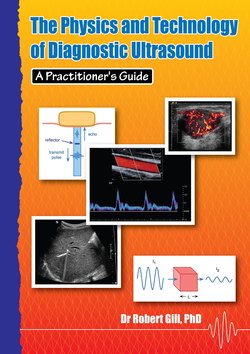Читать книгу The Physics and Technology of Diagnostic Ultrasound: A Practitioner's Guide - Robert Gill - Страница 32
На сайте Литреса книга снята с продажи.
Frame rate limitations
ОглавлениеNow that we know how to calculate the maximum allowable PRF that the machine can use, it is relatively easy to calculate the maximum possible imaging rate. Note that the number of images created each second is termed the "Frame Rate" (abbreviated FR).
If the machine requires N transmit pulses to create each image, it is easy to see that the total number of pulses required each second is simply (N × FR). Since the total number of transmit pulses available each second is by definition the PRF, we have:
and therefore
The frame rate is directly proportional to the PRF and inversely proportional to the number of pulses required to produce each image.
Now we can introduce the previously derived equation relating the maximum allowable PRF and the depth of penetration (P). This gives us the following relationship between the maximum possible frame rate, the depth of penetration and the number of transmit pulses required to create each image:
This is more commonly rearranged and written as follows:
Assuming that the frame rate (FR) is expressed in frames/ sec and the penetration (P) is measured in cm, then we can substitute the usual value for the propagation speed in soft tissue, converting it to cm/sec for consistency (i.e. c = 1540 m/sec = 154,000 cm/sec). This gives:
The product of the three quantities on the left of this equation is thus limited by a physical constant which we cannot alter (the propagation speed divided by two). Therefore, if we want to increase any one of these three quantities (e.g. frame rate), one or both of the other two must be decreased to compensate.
For example, consider an abdominal scan where we require a depth of penetration of 25 cm. Suppose that the ultrasound machine needs a total of 100 transmit pulses to create each image. Then the above equation tells us that the maximum possible frame rate is 30 frames per second.
While this is quite adequate for most applications, there are some clinical areas (such as echocardiography) where we may want to increase the frame rate above this value. Suppose we wanted a frame rate of 60 frames per second, but still required the 25 cm depth of penetration. Then the equation above tells us that the number of pulses for each image would need to drop to 50.
In echocardiography it is often possible to achieve this by narrowing the field of view of the transducer so that less pulses are needed to create each image.
We will revisit the issue of frame rate under the heading Temporal Resolution in chapter 10. In particular, we will take account of the fact that many machines are able to produce several beams at once. This "multiple beamforming" capability speeds up the acquisition of echo information, increasing the frame rate significantly.
SUMMARY
This story has become complex, so let us recapitulate:
To create an image, the machine transmits ultrasound pulses and collects the echoes that come back from structures within the tissues.
The time taken for each pulse to travel into the tissue and for the echoes to return depends on the depth of penetration (P) of the ultrasound; the greater the depth the longer it takes for the echoes to return.
The machine must transmit a number of pulses (N, typically 100 or so) to create each image.
Thus the overall time taken to produce one image will be determined by both P and N.
The number of images that can be produced each second (i.e. the frame rate FR) is therefore also a function of both P and N.
High frame rates can be achieved if the depth of penetration is small and/or if a relatively small number of transmit pulses are needed to create each image.
